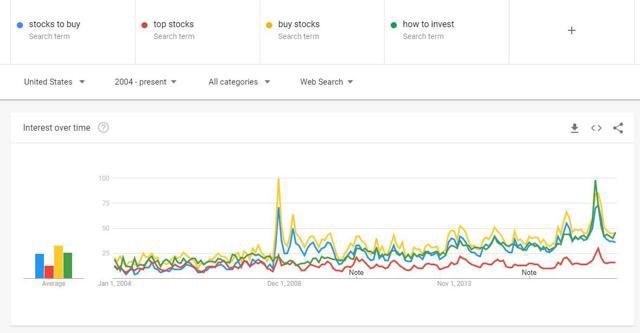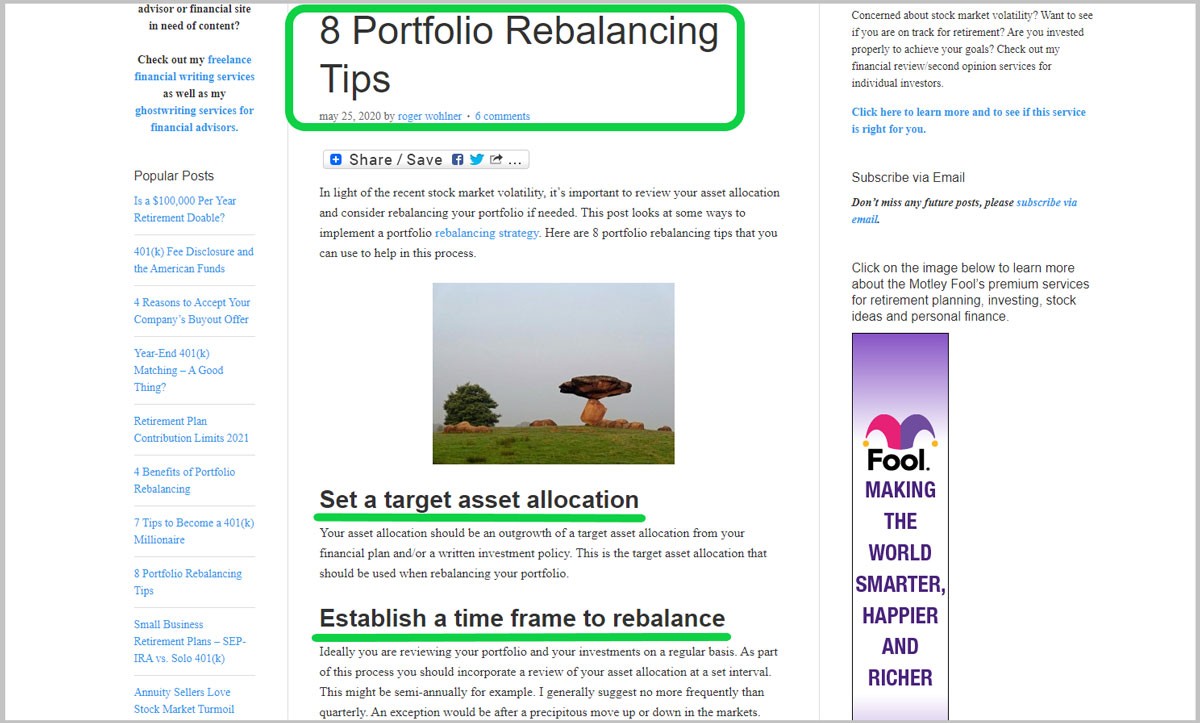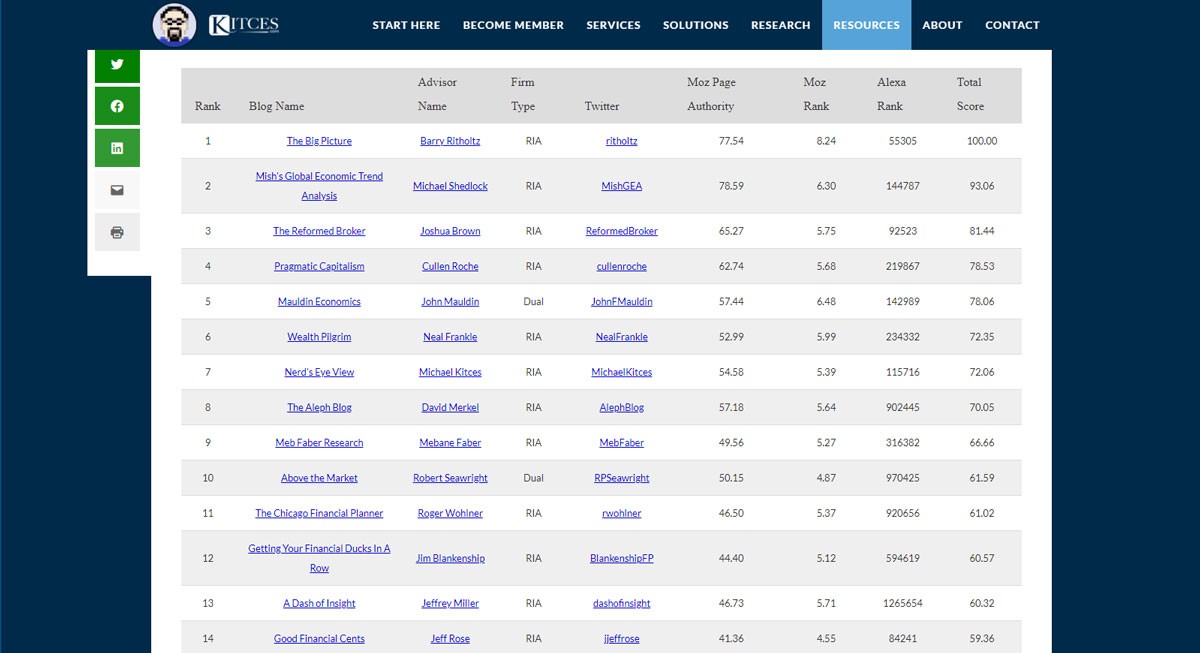Living as a professional financial advisor is a great way to help individuals and businesses alike when it comes to the overall health of their finances and financial future. If you are looking for ways to reach out to more prospective clients or if you are seeking a new platform to share your own financial advisor knowledge and expertise, consider launching your own advisor blog.
Launching a financial advisor blog of your own is one way to maximize your online reach as you also create a professional image and reputation for yourself locally and in your region. With the right marketing strategy and an understanding of the users and prospective clients you want to reach, work towards creating one of the best financial advisor websites available on the internet.
FACT: Content creation leads to 434% more indexed pages than websites without updated content. In fact, reports show that blogging (65%) is the most used content format. (99firms)
Financial Advisor Blog: Set Goals
If your goal is to run one of the top financial planning blogs, it is essential to set goals for yourself as well as the online presence you intend to develop and launch. Setting goals for yourself can help you to stay on track when crafting, sharing, and promoting your financial content.
Consider Your Purpose
Building the best financial advisor blog immediately right out the door is not likely, especially if you have not yet established your own presence online or yourself as a professional financial advisor throughout the industry. It is important to consider what purpose you intend to serve as well as what pain points and problems you intend to address and solve.
Are you interested in using your advisor websites blog to provide your readers with tips and tricks to obtaining loans, are you looking for a way to assist visitors with ways to be savvier when investing and saving their money? For example:

Define Your Audience
Knowing your audience is also key to any working marketing strategy online, especially for those entering the financial and financial advisor industries. Defining your audience is possible once you have determined the purpose of your blog and the pain points or problems you intend to resolve.
When creating an effective financial planning blog, consider what age range, gender, and even which location you are targeting based on the type of content you intend to write and produce. Consider who is likely to get the most value out of reading advisor websites blog content and the information you plan to write and share with your readers and online visitors.
Website and blog owners who are familiar with their main audience are much more likely to succeed when it comes to driving traffic and attracting new prospective clients and/or customers.
Brainstorm Your Content Strategy
Before you begin publishing information, tips, and financial planning strategies for your readers, brainstorm the content strategy that is right for you. Not all content marketing strategies will look alike, which is why it is imperative to know the type of content you intend to create, the audience you wish to appeal to, and the direction you want to take your financial blog into the future.
When thinking of content strategy ideas, consider the problems you will be addressing and attempting to solve for your readers. Will you be providing helpful tips for those interested in taking out loans for vehicles and homes, or are you interested in helping those who are entrepreneurs and looking to launch their very own startup business?
What do you want to be viewed as when others visit your financial planning blog? Do you want to be viewed as a financial mogul who has experience as an entrepreneur, or as someone who helps those who are simply trying to get by and become more acquainted with their finances as well as their own spending and saving habits?
Once your content is live, how do you plan to share it and spread the word about what you have published? Who is most likely to find your content titles and the subject matter interesting or of use to them? Which platforms are most likely to be used by your target audience who can use the content and information you intend to share?
Considering all of these factors as you brainstorm your content marketing strategy can be extremely helpful once you have your website and blog live and online.
Set Monetary Goals
Although you may not have the main goal of making money and generating revenue from your financial blog, it is important to consider the opportunities that you may encounter or that may arise over time. Setting monetary goals can also help you to remain focused and committed to publishing and sharing new content and blogs you produce on a regular basis.
You Might Also Like
With monetary goals in mind, you may also find yourself more motivated and committed to stay in touch with your current online followers and prospective clients and/or customers.
Even if the purpose of your financial planning blog is not to generate an income or any type of revenue, having monetary goals and opportunities in mind can be extremely beneficial for long-term scaling and growth.
Financial Planning Topics
Selecting topics you intend to cover on your advisor blog will likely vary depending on your own specialties as well as the time of year and what financial planning issues your readers may be struggling with themselves. Before choosing financial planning or financial advisor topics to cover, there are a few steps to keep in mind.
Keyword and Market Research
Conducting adequate keyword and market research is extremely important for any type of financial advisor or financial planning blog, regardless of your blog’s purpose, type of content, or primary audience. While you may have ideas for content when you are first starting off with your blog, you are likely to run into a creative block sooner or later.
Using various tools including Google Adwords and Google Trends (among other CRM systems and CMS solutions), research keywords, phrases, and trends in your financial niche or specialty market at any time. With trend-tracking tools, keep track of keywords that are most important to you based on your own financial experience and professional skills and abilities. Here is an example of Google Trends:

(Image Credit: Seeking Alpha)
Use keyword and trend market research to discover which topics are most likely to spark interest and garner views. It is also possible to use trend research to determine what type of problems or financial struggles your readers are experiencing based on location and geo-targeting elements you set.
Improve your content marketing + SEO in 60 seconds!
Diib uses the power of big data to help you quickly and easily increase your traffic and rankings. We’ll even let you know if you already deserve to rank higher for certain keywords.
- Easy-to-use automated SEO tool
- Get new content ideas and review existing content
- Checks for content localization
- SEO optimized content
- Built-in benchmarking and competitor analysis
- Over 500,000k global members
Used by over 500k companies and organizations:
Syncs with 
With enough keyword and market research, keep your content topics fresh and consistent year-round with valuable, informative, and unique information.
Did you know??? 50% of search queries consist of at least 4 words. (99firms)
Seasonal and Timed Topics
When you are in the process of conducting keyword trends and market research, consider topics that are optimal for certain times of the year. Crafting seasonal and time-sensitive content is one of the best ways to gain traction online for your new financial advisor website or financial planning blog.
Use eye-catching and relevant headlines to help attract viewers and to help spread the word about your blog, its name, and your professional reputation online. Use holiday-themed and seasonal financial headlines that can help to draw attention to your content and your website or your blog itself.
Keeping Up With the Latest Trends in Top Financial Advisor Blogs
Another way to ensure that your content remains fresh and not stale is to immerse yourself in online financial blogs and competing financial communities. Keep up with the latest trends in financial advisor blogs and financial planning websites by following top-performing bloggers in your market and niche.
Following financial advisor blogs and financial planning websites can also provide you with valuable insight into the financial planning community. Learn what users are asking about and what individuals are struggling with most in terms of their own financial wellbeing by reading comments and becoming engaged with various online forums, message boards, and groups.
The more immersed you become with the finance community online, the more inspiration you will likely receive when it comes time to create content that is worthy of publishing and sharing across all networks. Here is an example of an online community connected through Facebook. These groups are very easy to find and can be quite helpful.

Branding Yourself as a Professional Financial Advisor
Branding is one of the most key components of any successful business or brand, whether you are offering local services or building an international conglomerate. Before you can expect any level of success with your financial planning blog and website, you must first implement branding that is solely your own.
The Importance of Branding
Branding helps individuals to easily recognize and remember a business, brand, or even an idea. When you think of McDonald’s, Starbucks, or even Nike, the chances are that you can easily recall their logos and even their chosen color schemes. A properly branded business is memorable, relevant, and resonates with its intended audience or consumers.
Voice and Aesthetic
With a blog, website, or any type of online presence, you only have one opportunity to make a positive and lasting impression on your visitors and protective clients or customers. When you are creating a financial planning or financial advisor blog, it is important to consider what type of aesthetic and image you want to give off, along with the voice you intend to use when writing and publishing new content.
For a financial planning blog geared towards teenagers and young adults, choosing bright colors, illustrated graphics, and pop culture elements can help your blog to stand out. Opting for a fun, casual, and humorous voice can also help your blog to stand out amongst the competition as you build a sense of community among your readers and followers online.
However, if your financial planning blog is a blog based on your expertise as a financial for business investments, you may choose a serious and more corporate tone of voice. For a serious and more corporate blog, colors such as blues, black, white, and greens can be utilized to convey professionalism and trustworthiness. For instance:

Choosing Colors, Logos, and Proper Imagery
Selecting the colors, logo, and proper imagery for your financial planning blog matters, even if your subject matter itself has nothing to do with design or visually appealing elements itself. Choosing the right colors and logo for your financial planning blog greatly depends on the overall image you wish to convey as well as the type of persona you intend to use within the content you publish and share.
Create a Structured Content Outline
Once you have an understanding of the aesthetic, voice, and look you want to use for your financial planning blog, you can begin creating a structured content outline.
While you may feel tempted to dive right into crafting and publishing content, it is advisable to always have a structured content outline in place for each type of content you intend to share.
Having a structured content outline in place is optimal to help with saving time and to ensure all of your published pieces are properly formatted for search engines as well as your preferred blog or CMS (Content Management System) platform.
Use Eye-Catching Headlines
Using eye-catching relevant headlines also matters when crafting content. A headline that is boring, generic, or one that does not provide useful information is less likely to catch the eyes of followers and prospective clients. Spend time immersing yourself in competing financial communities and blogs to compare headlines and keywords used to drive traffic to various blogs and sites themselves.
Provide Actionable Steps
Use actionable steps whenever you are creating and sharing new content, even if your content may seem basic or uninspiring to you. Providing actionable steps to your readers throughout your content not only makes the content itself easier to skim and read, but it also adds tremendous value to the information you are offering your visitors.
Whether you are advising your readers on how to save and invest or if you are providing steps to opening a business while remaining financially-savvy, always use actionable steps within your structured content outline. For example:

Consider Keywords and SEO
A structured content outline can help you to ensure that your content is well-written and structured properly for SEO, or search engine optimization purposes. Whenever you are crafting new content for your website or blog, consider which keywords you should use to help with boosting your website’s ranking within top search engines such as Google and Bing.
Turn to your preferred keyword trend tracker to monitor overall trends within your preferred niche and market in the financial industry. Use trending keywords and phrases to help spread the word about your website and to boost your visibility within the first pages of search engine results.
Photos, Graphics, and Other Imagery
Photos, graphics, illustrations, videos, and other imagery can significantly increase the engagement your website and financial planning blog receives. Using visual elements can help to attract visitors and to catch the eye of those who may have a genuine interest in the financial content and information you publish and share.
We hope that you found this article useful.
If you want to know more interesting about your site health, get personal recommendations and alerts, scan your website by Diib. It only takes 60 seconds.
Use a main image as well as accompanying images or graphics throughout each of your guided tutorials or financial blog posts with actionable steps. Using graphics, videos, illustrations, and other imagery is a great way to also implement your own aesthetic and branding. Financial planning blogs that are complete with beautiful and attractive imagery are much more likely to succeed and reach a wider audience over time.
FACTS: 87% of video marketers say that video has increased traffic to their website. In fact, 80% of video marketers claim that video has directly increased sales. (HubSpot)
Provide Additional Resources
Another way you can help to establish a highly effective financial planning blog is to become a resource hub yourself. In addition to providing your visitors with high-quality informative and unique content, also consider the option of creating entire resource lists for those who are seeking additional information and guidance regarding their financial decisions.
Create a resource section of your website that not only includes clickable links to useful financial planning and financial management resources, but also direct phone numbers and other contact information (if applicable). For example:

Use your resource center or hub to attract new visitors and to also boost your website or blog’s own SEO within top search engines. By linking out to other third-party websites that are credible and verified within search engines, you can quickly improve your overall SEO in less time.
Having a resource hub or center on your website is also a way to establish yourself as a professional, credible, and trustworthy source online.
Diib®: Start Your Financial Blog Today!
Financial planning blogs do not have to be boring, dull, or dry. By better understanding the topics and subject matter your readers want to see and learn more about, you can quickly build one of the top financial advisor blogs on the web. Partnering with Diib Digital will give you an added measure of security. We offer a comprehensive User Dashboard that, among other things, can give you critical metrics and demographic information for your blog. This allows you to make strategic decisions based on statistical analysis.
Here are some of the features of our User Dashboard that set us apart from our competition:
- Keyword, backlink, and indexing monitoring and tracking tools
- Google Core Algorithm monitoring
- Blog campaign monitoring
- Alerts to broken pages where you have backlinks (404 checker)
- Alerts and Objective that guide you to strengthen your website
- Monthly call with a growth expert
Click here for your free 60 second site analysis and industry ranking or call 800-303-3510 to speak with one of our Growth Experts.



